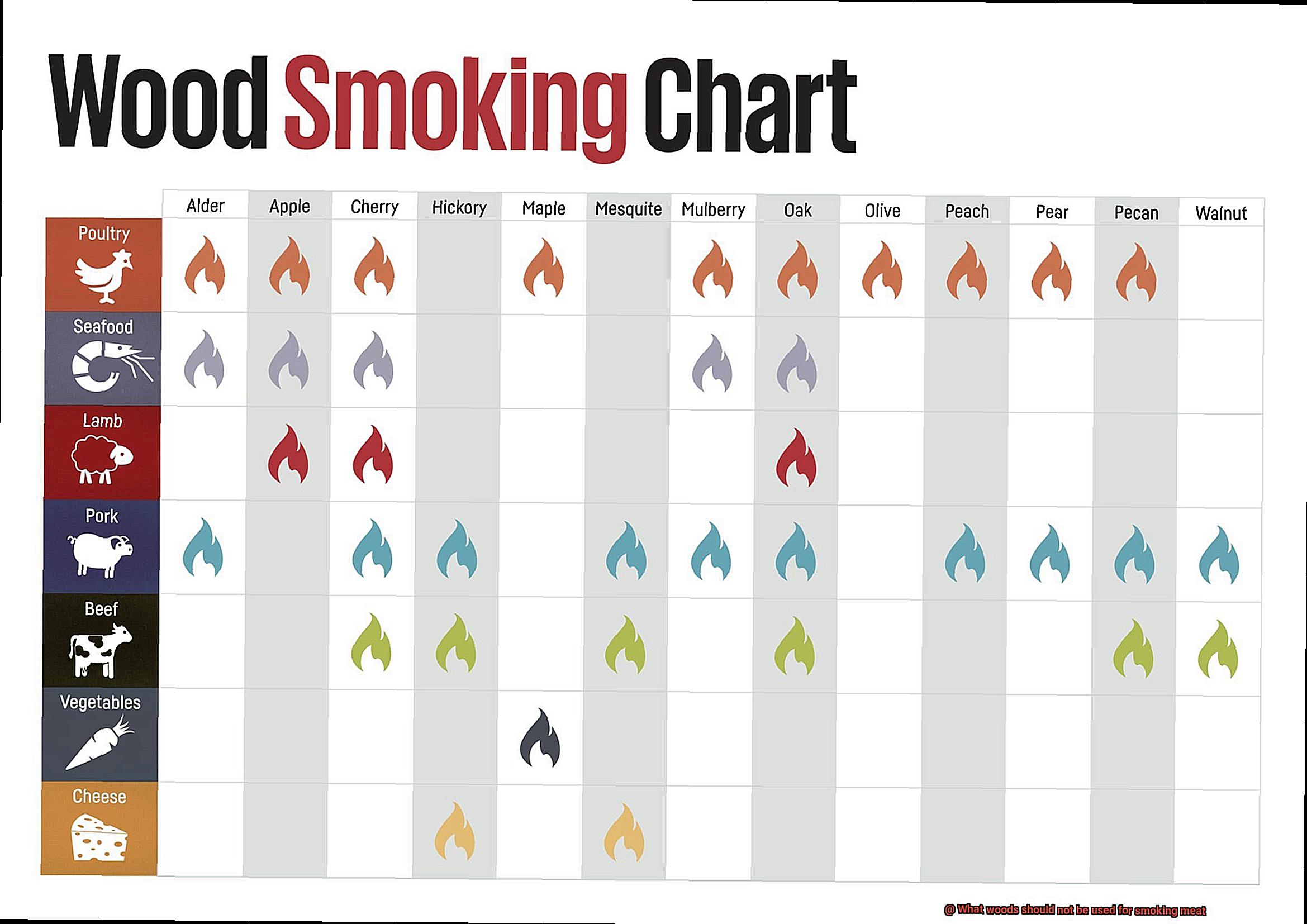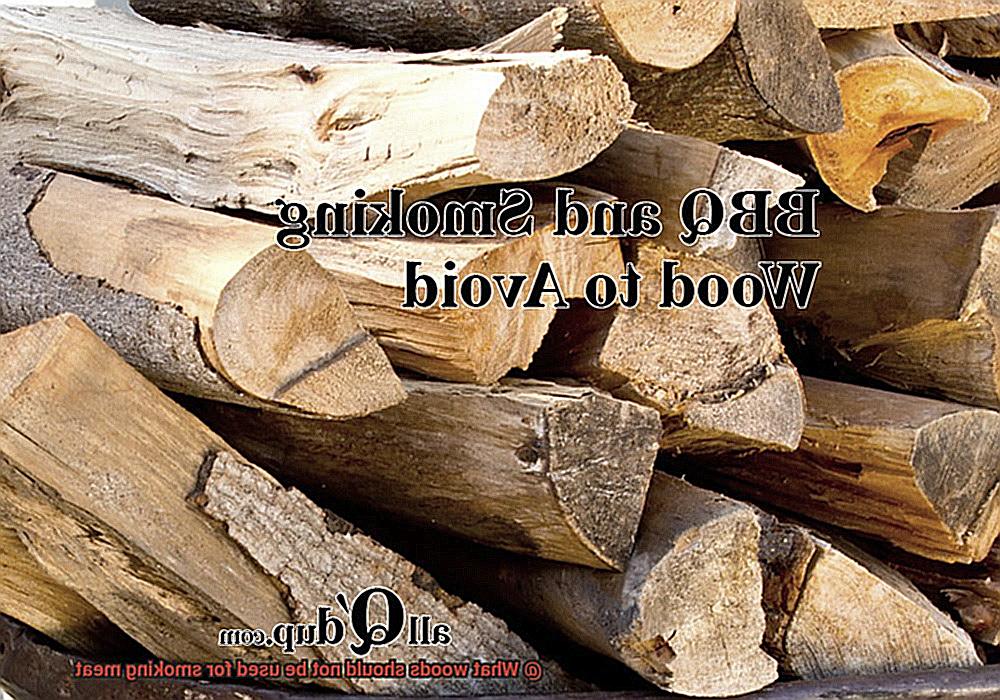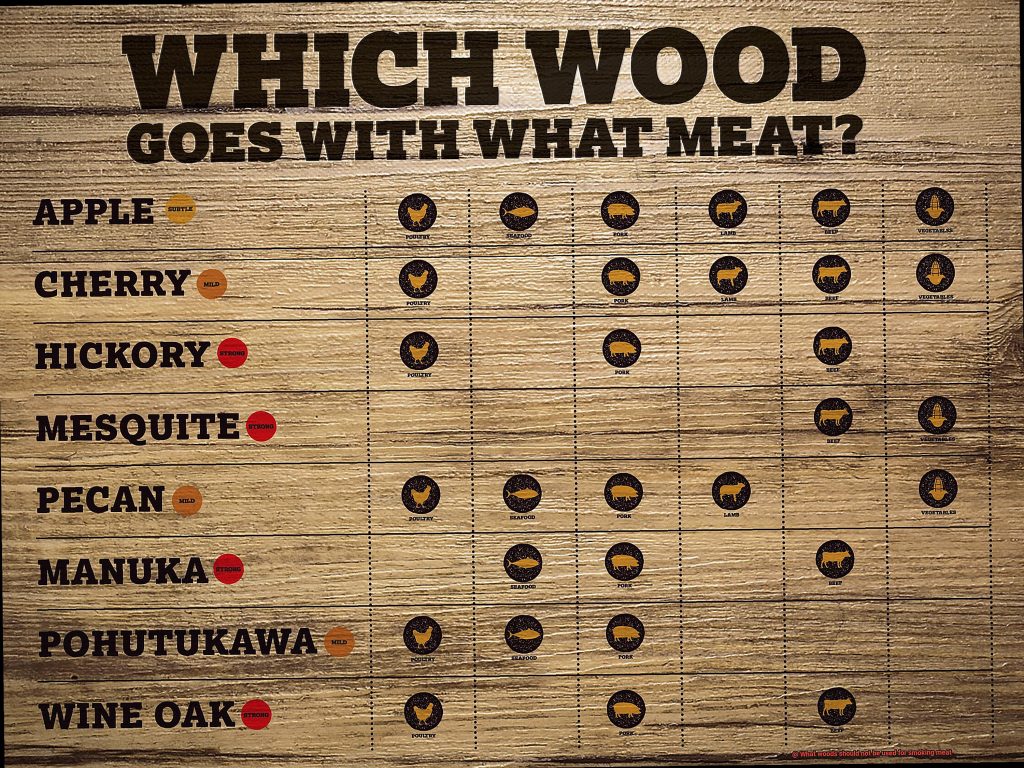Are you ready to fire up the grill and dig into some juicy, smoky meat this weekend? Hold on just a minute – before you start smoking your meat, it’s crucial to know that not all woods are created equal when it comes to flavor and safety.
Smoking meat is a time-honored tradition that can turn even the blandest cut into something mouth-wateringly delicious. However, using the wrong type of wood can quickly ruin your meal. Some woods can add an unpleasant taste or even be hazardous to your health.
In this blog post, we’ll delve into what woods should never be used for smoking meat. We’ll explore why conifers, softwoods, and high-resin woods are problematic choices and how they can taint your food with unwanted flavors.
We’ll also discuss the potential health risks associated with using unsuitable woods for smoking meat. From carcinogens to creosote buildup and respiratory issues, there are several reasons why choosing the right wood matters.

Whether you’re a seasoned pitmaster or a newbie in the world of smoking meat, keep reading to learn which woods you should avoid using for a safe and scrumptious barbecue experience.
Contents
What is Smoking Meat?
Smoking meat is a culinary tradition that has been around for centuries, dating back to early humans who used smoke to preserve their food. This cooking process involves using wood smoke to flavor and cook meat, infusing it with a delicious smoky taste while also tenderizing and preserving it for longer periods of time.

There are three main methods of smoking meat: hot smoking, cold smoking, and smoke-roasting. Hot smoking involves cooking the meat at temperatures between 165°F and 225°F, making it perfect for meats that need to be fully cooked like pork or chicken. On the other hand, cold smoking exposes the meat to smoke without cooking it, which is great for foods that are already cured like bacon or salmon. Smoke-roasting combines both methods by first cooking the meat at a low temperature and then finishing with a higher heat to achieve a crisp outer layer.
However, choosing the right type of wood is crucial to avoid any potential health hazards. Some woods contain toxins or chemicals that can be harmful when burned, such as treated lumber or wood from certain trees. Poison oak or poison ivy should be avoided at all costs as they can release harmful chemicals when burned. Woods that have been treated with chemicals or pesticides should also be avoided as these can release harmful fumes when burned.
Moreover, some types of wood have strong flavors or aromas that may not be suitable for all types of meat. Mesquite or hickory can be overpowering and may not be suitable for all meats, while cedar or pine can have a strong aroma that may not be desirable for some people.
To ensure a safe and delicious final product, it is best to choose woods that complement the type of meat being smoked and avoid toxic or treated woods. Woods like applewood, cherrywood, and oak are popular choices that provide a mild smoky flavor that pairs well with most meats.
Types of Woods to Avoid for Smoking Meat
Smoking meat is an art that requires careful consideration of the type of wood used. While some woods can enhance the flavor of the meat, others can be outright dangerous. Here are five types of woods that should be avoided when smoking meat.
Softwoods
Softwoods like pine, cedar, and spruce are not suitable for smoking meat. These woods contain high levels of resin and sap, which produce a bitter taste when burned. Worse yet, they release harmful chemicals into the air when burned, making them unsafe for consumption.
Poisonous woods
Poison oak, poison sumac, and poison ivy should never be used for smoking meat. When burned, these woods release toxic chemicals that can cause serious health risks if inhaled or ingested.
Treated woods
Pressure-treated lumber or wood that has been painted or stained should be avoided when smoking meat. These woods contain chemicals that are harmful to consume and can also release toxic fumes when burned.
Fruitwood with pesticides
Fruitwoods like apple and cherry are great for smoking meat, but it’s crucial to ensure they haven’t been treated with pesticides. Pesticides are harmful when ingested and can also release toxic fumes when burned, making them unsuitable for smoking meat.
Oak
While oak can give meat a great smoky flavor, it should be used in moderation. Too much oak can make the meat taste overly smoky and bitter, ruining the overall flavor.
Toxic Woods to Avoid
Nothing beats the tantalizing aroma of smoked meat wafting through the air. But before you get started on your next barbecue masterpiece, it’s crucial to know which types of wood to avoid. As an expert on toxic woods to avoid, I’ve got some valuable insights to help you create the best possible smoked meats.
Firstly, let’s address the elephant in the room: toxic woods. While it may be tempting to experiment with unique woods like poison oak, poison ivy, and oleander, these plants contain oils that can cause skin irritation, respiratory problems, and even death when ingested. So, never use these toxic woods for smoking meat or any other cooking purposes.
Next up are treated woods, including pressure-treated wood and painted or stained wood. These woods may contain chemicals like arsenic and creosote that can be harmful to humans when ingested. When you smoke with these types of wood, the chemicals can also be released into the air and onto your food. Therefore, it’s best to avoid using them altogether.
Now, let’s discuss woods that can produce a bitter taste in your meat. Pine and cedar are two examples of softwoods that can result in an unpleasant taste. These types of wood can also release harmful chemicals into the air and onto your food. Avoid using softwoods if you want to steer clear of a bitter taste and potential health hazards.
So what should you use instead? Hardwoods like oak and hickory are excellent options for smoking meat. They burn slowly and produce a rich smoky flavor that complements most meats perfectly. Fruitwoods such as apple or cherry are also great choices for adding a sweet and fruity flavor to your smoked meats.
Treated Woods to Avoid
Before you fire up that smoker, let’s talk about the importance of avoiding treated woods.
Treated wood may seem like a convenient option due to its resistance to rot and insect damage, but it comes with a serious health risk when used for smoking meat. The chemicals used in the treatment process, such as arsenic, chromium, and copper, are toxic to both humans and animals. When burned, these chemicals can contaminate your food and cause adverse health effects.
Here are three sub-topics to keep in mind when it comes to avoiding treated woods:
- Harmful Chemicals: The chemicals used in treated wood are hazardous to our health. Burning treated wood releases these harmful chemicals into the air and onto your food. To keep yourself and your loved ones safe, it’s essential to steer clear of treated woods.
- Respiratory Problems: Inhaling smoke from treated wood can cause respiratory problems like coughing, wheezing, and shortness of breath. This is particularly concerning for individuals with pre-existing respiratory conditions such as asthma.
- Identifying Treated Wood: Treated wood is often identified by its green or brown color and a stamp or tag indicating that it has been treated. Always read these tags carefully before using any wood for smoking.
So what’s the solution? Opt for natural hardwoods like hickory, mesquite, or oak instead. These woods provide a unique flavor profile to your dishes while also ensuring a safe and delightful smoking experience.
Strongly Flavored and Aromatic Woods to Avoid
As a connoisseur of the art of smoking meat, I can attest that not all woods are created equal. While some woods can infuse your meat with a delightful flavor and aroma, others can easily overpower the natural taste of the meat. It’s crucial to know which strongly flavored and aromatic woods to avoid when smoking meat to create an unforgettable culinary experience.
First and foremost, mesquite is notorious for overpowering the natural flavors of meat. Though it’s a popular choice for smoking meat in the southwestern United States, it’s best to use mesquite sparingly or avoid it altogether if you prefer a more subtle flavor.
Cedar is another wood that should be used with caution. While it’s often used for grilling salmon, its pungent flavor can be too much for other types of meat. Unless you’re looking for a cedar flavor specifically, it’s best to steer clear of this aromatic wood.
Hickory is another wood that needs to be used in moderation. It’s a classic choice for smoking meats like pork and beef, but its strong flavor can easily overpower your dish. Combining hickory with other mild woods such as apple or cherry can create a balanced flavor profile.
Pine should never be used for smoking or grilling. Not only does it impart a bitter taste to your meat, but it also contains high levels of resin and turpentine, which can be harmful if ingested.
Other Factors to Consider when Choosing Wood for Smoking Meat
Smoking meat is an art, and selecting the right wood is just as crucial as the preparation and cooking process. However, it’s not just a matter of choosing any old wood; you need to be mindful of the type of wood you use, as it can make all the difference in terms of taste, safety, and overall appeal. Here are some other factors to consider when choosing wood for smoking meat.
Firstly, resin content. Resin is a sticky substance found in certain types of wood that can create a bitter taste and harsh smoke when burned. Avoid woods with high resin content, such as pine, fir, and spruce. Not only do they give your meat an unpleasant taste, but they can also harm your respiratory system if inhaled.
Secondly, toxicity level. Some woods contain toxic compounds that can contaminate your meat and cause health problems. For example, cedar wood contains thujone, which can cause nausea, vomiting, and diarrhea if ingested in large quantities. Similarly, eucalyptus and sassafras contain safrole, a carcinogenic substance that can damage your liver. Always research the woods you plan to use to ensure they are safe for smoking meat.
Lastly, flavor profile. While some woods add a delightful depth of flavor to your meat, others can overpower it and ruin the entire experience. Woods like mesquite, hickory, oak, and pecan all have strong flavors that should be used with caution and moderation. Consider the type of meat you’re smoking and choose a wood that complements its natural flavors rather than overpowering them.
e_ihPPARY9A” >
Conclusion
Smoking meat is a culinary art that requires the right ingredients to create a mouthwatering masterpiece. One crucial factor to consider is the type of wood used, as it can make or break the flavor of your meat. While some woods are perfect for smoking, others should never be used due to their dangerous or unpleasant properties.
Softwoods like pine, cedar, and spruce may seem like an easy option, but they contain high levels of resin and sap that produce a bitter taste when burned. Not only does this ruin the taste of your meat, but it also releases harmful chemicals into the air that can be hazardous to your health. Similarly, poisonous woods such as poison oak or poison ivy should never be used for smoking meat as they release toxic chemicals when burned.
Treated woods like pressure-treated lumber or painted/stained wood are also off-limits for smoking meat. These types of wood contain harmful chemicals that can be dangerous to consume and can even release toxic fumes when burned. Additionally, some fruitwoods may contain pesticides that are unsafe when ingested or inhaled.
On the other hand, hardwoods such as oak and hickory are excellent choices for smoking meat. They burn slowly and provide a rich smoky flavor that complements most meats perfectly. When selecting wood for smoking meat, it’s essential to consider factors such as resin content, toxicity level, and flavor profile.
By choosing the right wood for smoking meat and avoiding toxic or treated woods altogether, you’ll ensure a safe and delicious final product that will leave your guests begging for more.






